 Family: Viperidae (Vipers)
Family: Viperidae (Vipers)Subfamily: Crotalinae (Pit Vipers)
Genus: Calloselasma
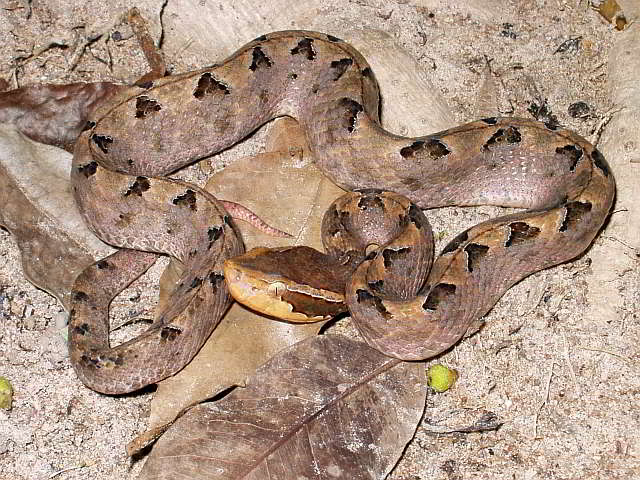
Picture: J. Bulian
 Calloselasma rhodostoma (Malayan Pit Viper)
Calloselasma rhodostoma (Malayan Pit Viper)Thai:
 (ngu gap pha)
(ngu gap pha)Length: Up to 100 cm
Distribution area: Resident in the whole of Thailand and is often found under dry leaves, stones or old wood.
Behaviour: Predominantly nocturnal especially when it is drizzling, but also active during the day. It bites, is an aggressive snake and advances very quickly.
Danger level: Strong venom, deadly!

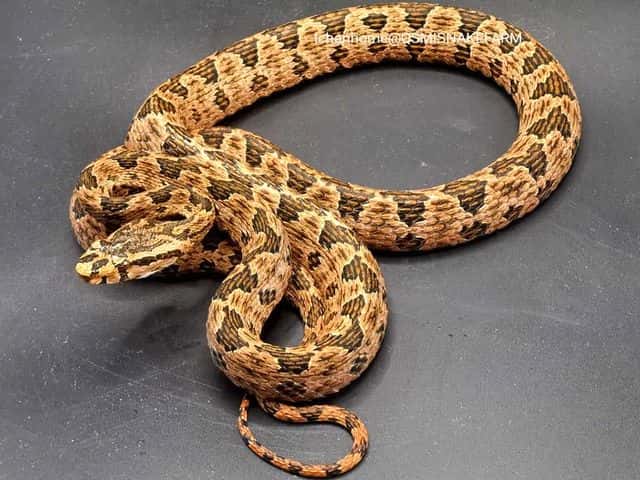
Picture: Dr. Lawan Chanhome
 Protobothrops kelomohy (Omkoi Lance-headed Pit Viper)
Protobothrops kelomohy (Omkoi Lance-headed Pit Viper)Thai: ngu kelo omkoi
Length: 110 cm - male, 132 cm - female
Distribution area: Chiang Mai province
Behaviour/habitat: The Omkoi Lance-headed Pit Viper was just described by a team of thai herpetologist beginning of 2020. For that reason only a little is known abou this species until now. All snakes found until now were found in the jungle at a hight between 600 and 1000 meters above 0. 2 snakes were found in the jungle near rocks. 1 animals was observed near a nature reserve. This species is active at night. The females are laying eggs.
Danger level: About the strenghts of the venom nothing is known until now.
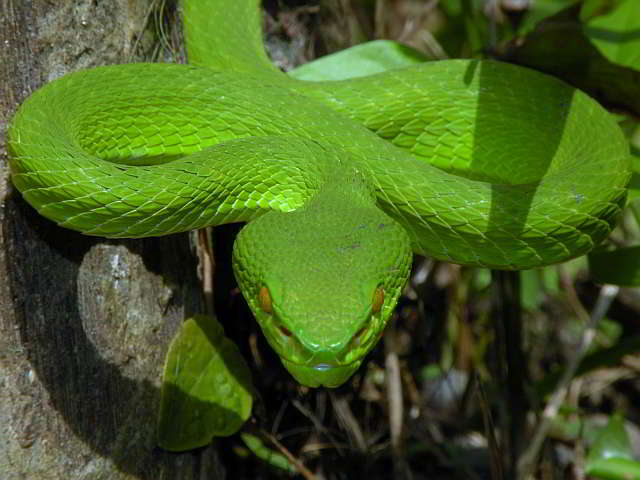
Picture: J. Bulian
 Trimeresurus (Trimeresurus) albolabris
Trimeresurus (Trimeresurus) albolabris(White-lipped Pit Viper)
Thai:
 (ngu khiau hang mei tong loeng)
(ngu khiau hang mei tong loeng)Length: 75 cm - male, 104 cm - female
Distribution area: Throughout Thailand
Behaviour/habitat: The White-lipped Pit Viper is a very adaptable snake which can be found in wooden and bushy open areas up to 500 meters. It is often found near human settlements. It prefers to stay near to the water. The snake is nocturnal and in search for food (rodents, frogs, lizards, birds) they also move on the ground at night. The Pit Viper strikes quickly and accidents with humans happen frequently. White-lipped Pit Vipers mate in Thailand in September and October. The females give birth up to 16 offspring, which are born in a membrane which the babies break open just after birth. The juveniles have the same coloration as the adults.
Note: A normal person cannot tell the difference between the green Pit Vipers. The following Pit Vipers, present in Thailand, have a green colour:
● Cryptelytrops (Trimeresurus) albolabris (White-lipped Pit Viper)
● Viridovipera (Trimeresurus) gumprechti (Gumprecht's Pit Viper)
● Parias (Trimeresurus) hageni Hagen's Pit Viper
● Cryptelytrops (Trimeresurus) macrops (Large-eyed Pit Viper)
● Popeia (Trimeresurus) popeiorum popeiorum (Popes Pit Viper)
● Popeia (Trimeresurus) fucatus
*in the works from MALHOTRA & THORPE (2004) not yet entered MALHOTRA & THORPE follows, entered here under the name Popeia
● Parias (Trimeresurus) sumatranus (Sumatra Pit Viper)
● Viridovipera (Trimeresurus) vogeli (Bird Pit Viper)
● Cryptelytrops cardamomensis (Cardamom Mountains Green Pitviper)
Danger level: There is a serum against all green Pit Vipers available in Thailand. Bites are very painful but do not usually end fatally. A bad bite can lead to necrosis.
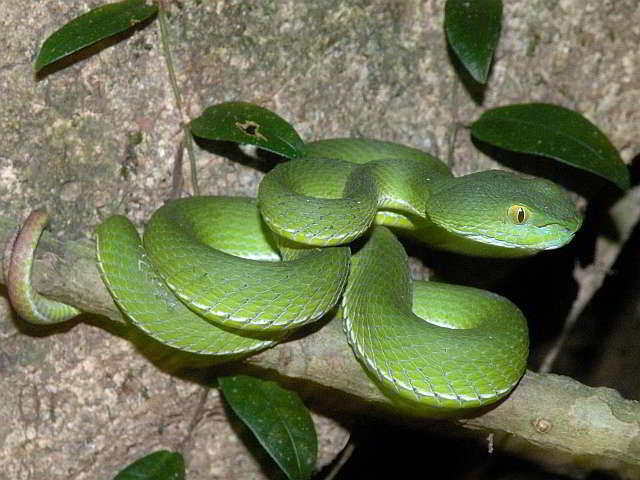
Picture: J. Bulian
 Trimeresurus (Trimeresurus) cardamomensis (Cardamom Mountains Green Pitviper)
Trimeresurus (Trimeresurus) cardamomensis (Cardamom Mountains Green Pitviper)Thai: (ngu khiau hang mei)
Length: 50 cm male, 75 cm female
Distribution area: Chantaburi province
Habitat/behaviour: The Cardamom Mountains Green Pitviper was newly described in 2011. It is very similar to the Big eye pitviper (Cryptelytrops macrops). This snake is nocturnal and then hunts rodents, lizards and frogs. They mainly can be found near the ground. Mostly they don't move higher than 1 meter in the vegetation. From my own observation on the island of Koh Chang, where this snake also can be found, nearly all individuals were found near the ground. Like Cryptelytrops macrops and Cryptelytrops venustus these snakes seem to live in small island like habitats in a high number of individuals. Outside this habitat (mostly beside a small creek or the valley between two mountains) hardly any of this vipers can be found. Cryptelytrops cardamomensis is not an aggressive snake. From all the snakes I handled for the photo session, none did try to bite. But of course they are venomous, so inexperienced persons should not handle this or any other venomous snake. About the reproduction of the Cardamom Mountains Green Pitviper until now nothing is known. But most likely the mating season will be same as Cryptelytrops macrops in
Danger level: There is a serum against all green Pit Vipers available in Thailand. Bites are very painful but do not usually end fatally. A bad bite can lead to necrosis.
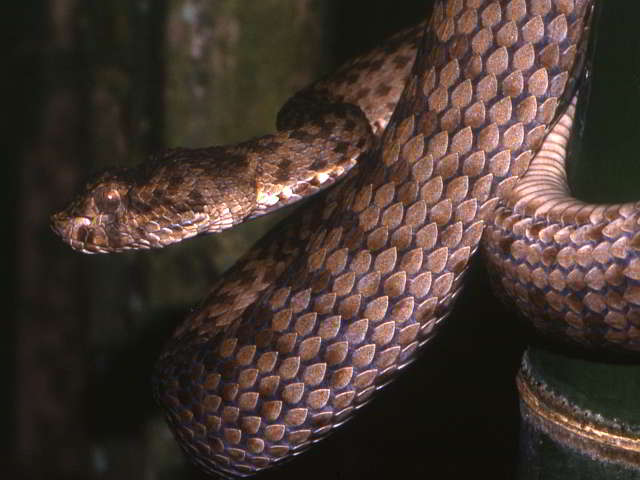
Picture: J. Bulian
 Trimeresurus (Trimeresurus) kanburiensis
Trimeresurus (Trimeresurus) kanburiensis(Kanburi Pit Viper)
Thai:

Length: 70 cm
Distribution area: Province of Kanchanaburi
Habitat/behaviour: This species was described in 1934 by the British herpetologist, Malcolm Smith, using a female specimen from the limestone mountains around Kanchanaburi. Due to its origin in the province of Kanchanaburi, which was formerly called Kanburi, the snake was then given the name kanburiensis.
Almost nothing is known about the living habits of this snake in its natural environment. We do not know whether the snakes inhabit trees as a natural habitat or whether they live on the ground like the Cryptelytrops venustus which live around the limestone mountains and look very similar. The snakes are active at dusk and at night. The mating season for the snakes is in September and October. During this time the snakes are also active during the day, especially the males, and the chance of meeting this snake in these months is very high. The snakes go into hiding in the dry season and re-emerge at the beginning of the rainy season in April. This is also when the females give birth to their young.
Danger level: One bite and has been documented in literature with reference to the venom of this snake. The bite does not result in death but long-term treatment in hospital is necessary. Semi-venomous, rarely deadly!
Danger of confusion:
● Cryptelytrops venustus
● Cryptelytrops purpureomacultus
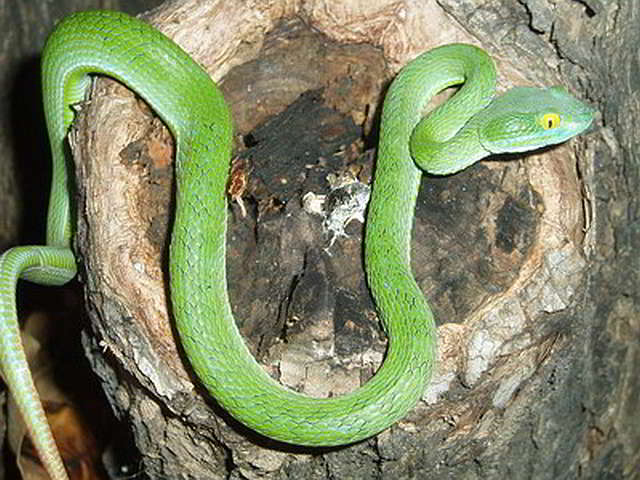
Picture: J. Bulian
 Trimeresurus (Trimeresurus) macrops
Trimeresurus (Trimeresurus) macrops(Large-eyed Green Pit Viper)
Thai:
 (ngu kiau hang mei ta to)
(ngu kiau hang mei ta to)Length: up to 72 cm
However these snakes usually only reach a length of around 50 cm.
Distribution area: Northern and central Thailand. These little venomous snakes are often found in the area around Bangkok.
Habitat and behaviour: This is, just like other species of Pit Vipers, a snake which is active at night. When twilight falls, these snakes leave their daytime hideouts in bushes and trees where they sleep curled up in a ball, and go on the hunt in shrubs and on the ground for frogs, lizards, birds and rodents. Cryptelytrops macrops is easily recognisable from other species of Pit Vipers due to its large yellow eyes. Although these animals usually sit on branches and ignore passers-by, they can bite as fast as lightning.
Danger level: Just like other species of Pit Vipers. The venomous may be a little stronger than that of Cryptelytrops albolabris. A venom bite does not generally lead to major complications.
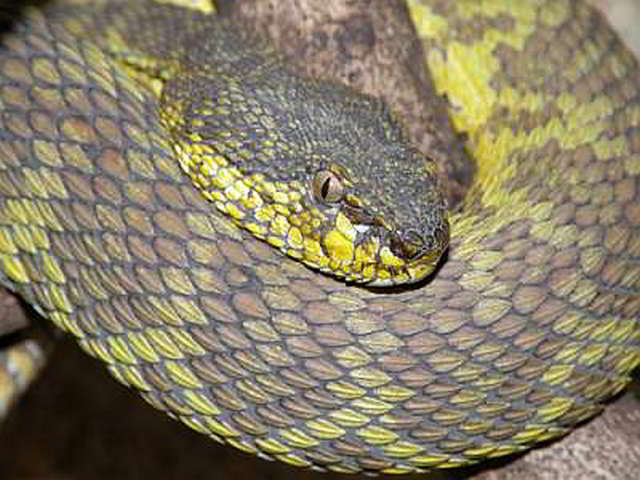
Picture: J. Bulian
 Trimeresurus (Trimeresurus) purpureomaculatus (Mangrove Pit Viper)
Trimeresurus (Trimeresurus) purpureomaculatus (Mangrove Pit Viper)Thai:
 (ngu pang ka)
(ngu pang ka)Length: 100 cm
Habitat: To be found on covered river banks, in swamps and in hilly areas.
Behaviour: An easily excitable, aggressive snake, which advances very quickly over a distance.
Danger level: Semi-venomous, rarely deadly!
Danger of confusion:
● Cryptelytrops venustus
● Cryptelytrops kanburiensis
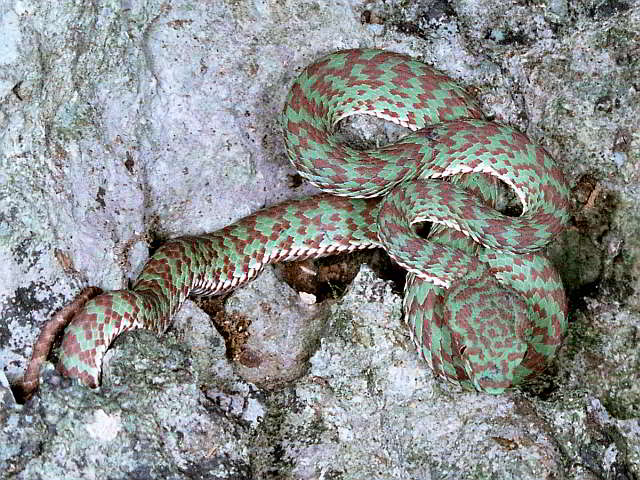
Picture: J. Bulian
 Trimeresurus (Trimeresurus) venustus (Brown-spotted Green Pit Viper)
Trimeresurus (Trimeresurus) venustus (Brown-spotted Green Pit Viper)Thai:

Length: Max. 70 cm, but usually smaller
Distribution area: Between Chumphon and Krabi
Behaviour/habitat: The Coloured Pit Viper prefers life in the woods and on limestone mountains but can also be found on rubber plantations. The snake is mainly nocturnal. The snakes are active during the day only after heavy rainfall. The snake lives almost only on the ground where it hunts frogs and lizards. The snake is very peaceful and only bites if seriously aggravated.
Danger level: Scientific studies on the strength of the venomous have not yet been carried out. Reports from bite victims lead us to believe that the venomous is not as strong as the White-lipped Pit Viper. Victims have reported pains but no long-lasting effects.
Danger of confusion:
● Cryptelytrops kanburiensis
● Cryptelytrops purpureomacultus
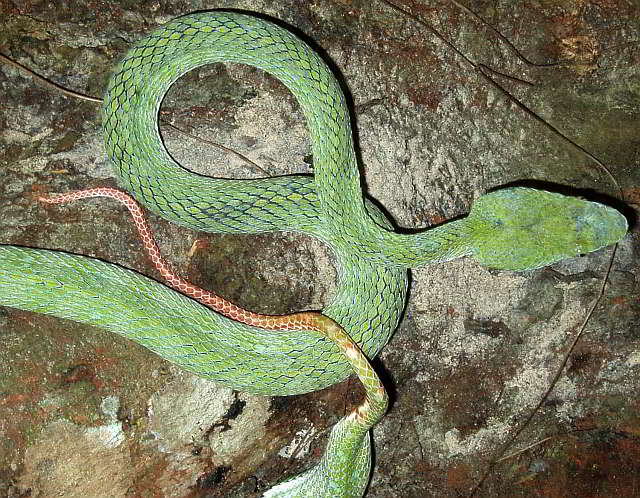
Picture: J. Bulian
 Trimeresurus (Parias) hageni
Trimeresurus (Parias) hageni Thai:
 (ngu kieo hang mei)
(ngu kieo hang mei)Length: up to 116 cm
Distribution area: In the provinces of Songkhla, Suratthani and Trang
Habitat/behaviour: Parias hageni resides in the flatland rainforests. It can usually be found after rainfall at night. The snakes are active in trees and bushes as well as on the ground. Hagen’s bamboo viper is generally calm snake which does not bite as quickly as most of the other Pit Vipers. This species differs from the other green Trimeresuru species due to the relatively clear markings and especially due to the fact that the animals look very slender.
This species lays eggs. The young snakes, hatching from the 13 to 17 eggs after an incubation period of approximately 35 days, are approximately 240 mm long.
Danger level: Although Parias hageni rarely bites, it is recommended that care is taken with this species. There are no recorded deaths caused by a bite from the species that bites can lead to extremely painful swelling.
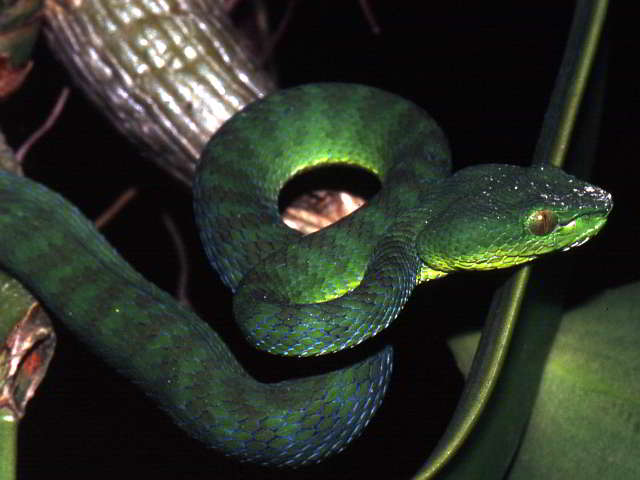
Picture: J. Bulian
 Trimeresurus (Popeia) popeiorum popeiorum
Trimeresurus (Popeia) popeiorum popeiorum(Pope's Pitviper)
Thai:
 (ngu kiau hang mei tong kiau)
(ngu kiau hang mei tong kiau)Length: Up to 90 cm
Distribution area: To be found in central and west Thailand in the rain forest.
Behaviour: A nocturnal, aggressive and biting snake which advances very quickly over a distance. During the day it lies around in the trees. At night it is on the move on the ground.
Danger level: Very strong venomous! Painful, strong swelling around the bite wound!
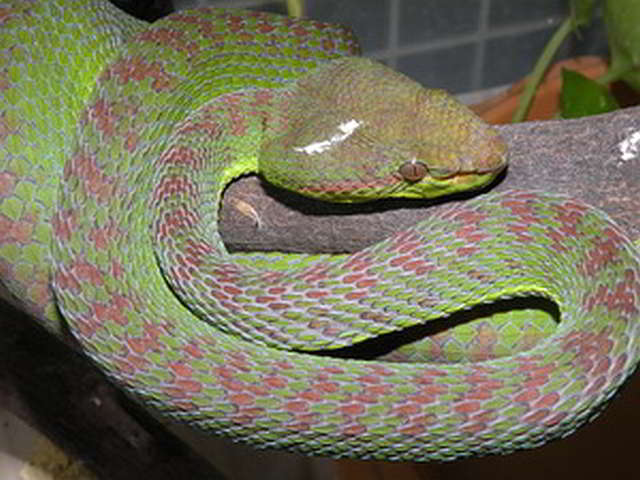
Picture: J. Bulian
 Trimeresurus (Popeia) phuketensis (Phuket Pit Viper)
Trimeresurus (Popeia) phuketensis (Phuket Pit Viper)Length: Males up to 64 cm, females 75 cm
Distribution area: Phuket, Ban Bangrong, Thalang District
Habitat/Habits: The Phuket Pit Viper was described as a new species in 2011. Therefor there a only few informations about this snake. The distibution is, as far as known until now, limited to a small region in the north of Phuket Island. Like the other Trimeresurus species, also Trimeresurus phuketensis is active during the night. Mostly this snake lays near the ground on bushes or branches. Occasionly they also can be found on the ground. Their habitat are primarely and secondarly forests.
The breeding season of this snakes are the months september and october. At this time the snakes are also the most active. After a gravidity of 5 months the females give births to 8 to 9 living offspring.
In captivity this snakes did feed on a wide variety of food. They did accept geckos, frogs, mice, rats and bats.
Danger level: Like with all other Trimeresurus species , also Trimeresurus phuketensis should be handeled with respect. As this species is still quite new, there do not exist any informations about how strong the venom is. Also is not known how effective the from the Red Cross in Thailand droduced Green Pit Viper sera is in a case of a bite from Trimeresurus phuketensis. A special sera against the venom from the Phuket Pit Viper does not exist in the moment.
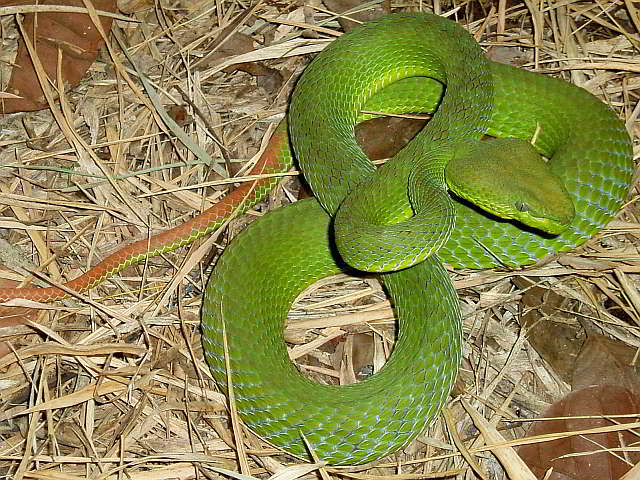
Picture: J. Bulian
 Trimeresurus (Popeia) fucatus
Trimeresurus (Popeia) fucatusThai: (ngu khiau hang mai)
Length: up to 85 cm however the snakes are usually smaller.
Distribution area: Southern Thailand from Chumphon to the Malaysian border
Habitat/behaviour: There is hardly any information about the living habits of this species because it was first described in 2004 with an example from Nakhon Si Tammarat. Due to the fact that this species belongs to the Parias popeiorum group and was also recorded as Trimeresurus popeiorum up until 2004, we can assume that it has the same habitat and behaviour as the Parias popeiorum. In addition to the scales and the different DNA, this species differs from Cryptelytrops albolabris and Parias popeiorum with the slightly longer head and the bands across the front of the body. However, it is generally difficult for someone, especially someone who has not intensively studied the species, to differentiate between the different snakes.
Danger level: Tests on the effects of the venom have not been performed yet but we can assume that it is similar to Parias popeiorum.
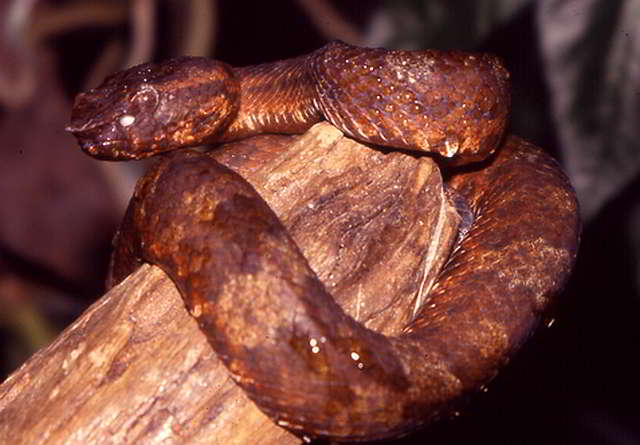
Picture: J. Bulian
 Trimeresurus (Craspedocephalus) wiroti (Wirots palmviper)
Trimeresurus (Craspedocephalus) wiroti (Wirots palmviper)Length: up to 89 cm, usually smaller
Distribution area: Southern Thailand in the provinces of Krabi, Nakhon Si Thammarat, Narathiwat and Trang
Habitat/Behaviour: Trimeresurus wiroti inhabits mostly lowland rainforests and tropical wet forests up to 750 meters. According to information’s from local snake catchers in southern Thailand, this species mostly is found near brooks, rivers or ponds. Most animals were found on the ground, near the ground or on bushes. In the recent literature there are also references about sightings in the treetops more than 20 meters above the ground. The snakes are nocturnal and feed mostly frogs. But also birds and rodents are accepted.
At the original place where the snake was found first (the typus was found there) Baan Hui Hip, Amphoe Chawang in the province of Nakhon Si Thammarat this snake probably can not be found any more, as nearly the whole area was transferred into rubber plantations. Also none of the villagers there, which I questioned in 2004, could remember to have seen this snake in the last 10 years. The occurrence in the Thungsong area and south of this is certain.
The snake lays eggs. Between 13 and 17 eggs are deposit, which the female incubates. The hatchlings have a total lengths of about 240 mm at birth.
Besides the here shown red-brown colour variation there are grey-brown animals with black spots on the back or grey to grey-brown specimen with green or greenish spots.
Danger level: Whereas from some authors the venom of Trimeresurus wiroti is described as mildly venomous, one should handle the snake with care. A bite with both fangs from an adult snake, for sure has serious consequences.
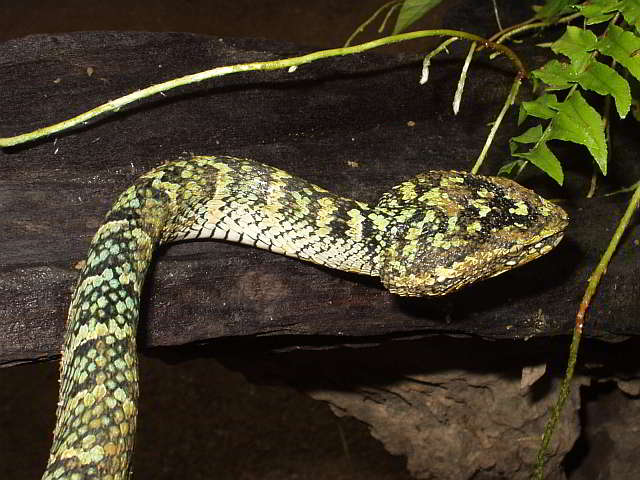
Picture: J. Bulian
 Tropidolaemus wagleri (Wagler's Pitviper)
Tropidolaemus wagleri (Wagler's Pitviper)Thai:
 (ngu kiau tuck gä)
(ngu kiau tuck gä)Length: Max. 100 cm. The male remains smaller than the female.
Distribution area: In southern Thailand from the Khao Sok National Park and Takua Pha up to the Malayan border.
Behaviour/habitat: The Wagler’s Pit Viper is nocturnal snake and a resident of the lowlands. It lives in primary and secondary forests and in mangrove forests. In these forests, it is mostly found in bushes and on branches at a height of 2 meters. These snakes do not move very much and sometimes spend weeks in the same spot without moving . In general, the animal does not bite quickly but can strike out extremely quickly.
Danger level: The venomous brings on pain and swelling in humans but is not usually fatal.
Mildly-venomous/non-venomous snakes of Thailand
Venomous snakes of Thailand
≡ Menu
All data is provided without guarantee!